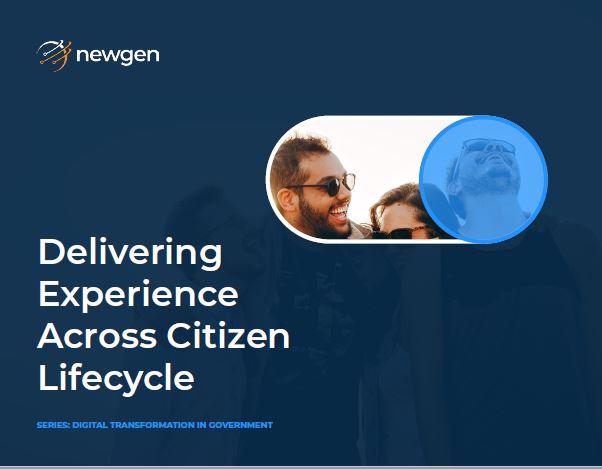Advancing Public Service Delivery Through Connected, Digital Government
Governments everywhere are facing a shift in citizen expectations. As people increasingly experience fast, convenient digital services in their daily lives, they now expect the same ease and responsiveness when engaging with public institutions. However, many government agencies remain anchored to outdated, siloed systems that slow decision-making, increase administrative effort, and leave citizens disappointed.
This eBook explores how governments can deliver seamless experiences throughout the citizen lifecycle by redesigning services around people rather than departments. When agencies modernize operations and connect data, they enable faster access to essential services, reduce friction in life events, and strengthen trust and transparency with the public.
The New Expectations of the Modern Citizen
Citizens want digital experiences that are:
- Easy to access from any device
- Personalized, not generic
- Fast and predictable
- Secure and transparent
- Connected across agencies and services
They are no longer willing to accept delayed approvals, repeated documentation, or limited visibility into progress. The pressure on government to modernize and provide intuitive services has never been greater.
Why Government Transformation Has Been Difficult?
Government services are built on agency structures that operate independently. This leads to:
- Fragmented journeys with multiple handoffs
- Long wait times caused by manual workflows
- Legacy systems that hold critical data in isolation
- Limited visibility across departments
- Repetitive requests for identity, documents, and updates
- Operational risks associated with large-scale change
Without a unified view of the citizen, each interaction feels disconnected, forcing individuals to carry the burden of navigating the system on their own.
A Citizen-Lifecycle Approach to Public Service Delivery
Transforming individual processes alone is not enough. Governments must design experiences based on key stages and life events that define citizen need.
Some major lifecycle milestones include:
- Identity creation at birth
- Enrollment in education and social programs
- Employment and business support services
- Marriage, relocation, and family transitions
- Healthcare support and long-term wellbeing
- Legal services and property management
- Senior citizen services and end-of-life support
A citizen-first view enables agencies to anticipate needs instead of react to requests.
Real Stories That Reflect Real Challenges
The eBook walks through a multi-generational family to illustrate how disconnected services cause frustration. Their experiences reveal that:
- Adoption and foster care systems lack timely guidance
- Scholarships and license processes remain slow and manual
- NGO registrations and grant approvals are overly complex
- Case tracking across the legal system is opaque
- Government employees lack digital support at work
These examples reflect common global scenarios where process complexity prevents successful public outcomes.
What a Transformed Citizen Experience Looks Like?
Digitally advanced governments support connected journeys across every life stage. This includes:
- Seamless Digital Service Requests
Citizens can apply, upload documents, pay fees, and track requests from anywhere.
- Unified Collaboration Across Agencies
Requests flow automatically to the right departments with full status visibility. - Proactive Communication
Notifications keep citizens informed instead of requiring follow-up calls or visits. - Personalization at Scale
Service recommendations and eligibility are based on validated data already on record. - Secure Data Management
Documents and certifications are safely stored once and referenced everywhere.
Better experience leads to faster access to benefits and improved satisfaction with public sector services.
Employee Experience Matters Too
Citizen service cannot improve unless government employees are empowered. Digital workplaces help officials:
- Reduce manual processing time
- Access complete information without switching systems
- Collaborate across departments
- Respond to cases more confidently
- Work productively in hybrid environments
When employees have the right tools, citizens benefit instantly.
Technologies That Enable Connected Public Services
Governments require platforms that combine:
- Automated workflows to remove administrative delays
- Intelligent document handling for faster approvals
- Integrated communication to support real-time collaboration
- Secure and compliant data environments
- Configurable systems that adapt to evolving policies
- Analytics to measure service efficiency and outcomes
Technology becomes the backbone of citizen-centric governance.
The Measurable Impact of Digital Experience
Governments that shift to citizen-first journeys gain:
- Higher satisfaction and trust among the public
- Better service delivery without expanding workforce
- Reduced operational cost through automation
- Stronger compliance and audit readiness
- Improved transparency and accountability
- A more resilient and future-ready operating model
Transformation fuels progress across economic and social development goals.
How Newgen Supports Citizen Experience Transformation?
Newgen helps government organizations unify citizen interactions with a digital platform that connects processes, documents, and communications. Agencies gain visibility into every case, automate manual tasks, and coordinate service execution across departments. The result is a simpler way for people to access services and a more collaborative approach to public service delivery.
A Better Citizen Experience Builds a Better Nation
Every interaction with government shapes public perception and trust. When services become connected, intuitive, and fast, people feel valued and confident in the institutions that serve them. By adopting a digital-first approach to the entire citizen lifecycle, governments strengthen civic participation and enable impactful outcomes for society.
The time to transform is now. Citizen expectations will only continue to rise, and the governments that act today will lead in delivering the experiences that define the future of public service.

